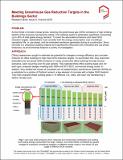| dc.description.abstract | As the threat of climate change grows, lowering the greenhouse gas (GHG) emissions of high emitting sectors of the economy has become critical. The buildings sector is particularly significant, consuming up to 40% of total global energy demand. To lower the associated emissions and meet GHG reduction targets, stakeholders must consider both the energy consumption over a building’s operational life, or use phase, and the embodied emissions generated during its construction. Since concrete is a ubiquitous building material and significantly influences both embodied and use phase emissions, its environmental footprint is worthy of investigation. | en_US |
